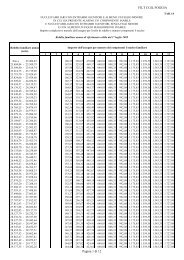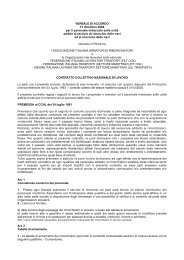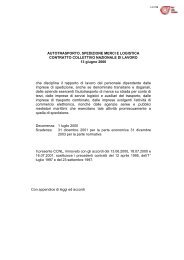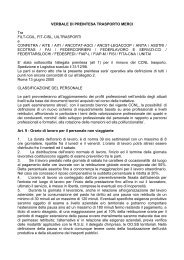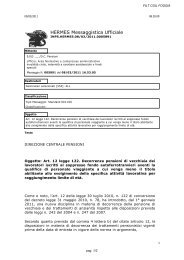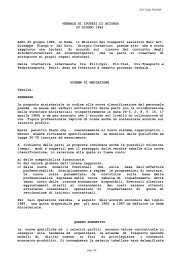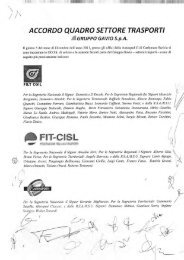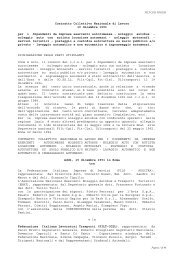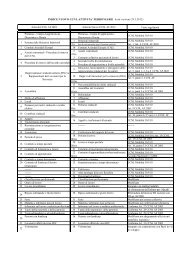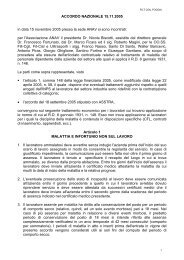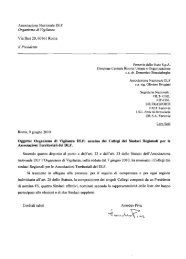Outlook for Air Transport to the Year 2025 - FILT CGIL Foggia
Outlook for Air Transport to the Year 2025 - FILT CGIL Foggia
Outlook for Air Transport to the Year 2025 - FILT CGIL Foggia
- No tags were found...
Create successful ePaper yourself
Turn your PDF publications into a flip-book with our unique Google optimized e-Paper software.
Chapter 2. <strong>Air</strong> <strong>Transport</strong> Trends and Challenges 21routes, high frequencies, simple low-fare structures, high-density single class with no seat assignment, simplein-flight services, staffing flexibility and minimal overheads, and intensive use of electronic commerce <strong>for</strong>marketing and distribution (including online booking via <strong>the</strong> Internet and electronic ticketing). To sustainlow-cost structures, <strong>the</strong>se airlines usually operate a single aircraft type with high daily aircraft utilization. Theyalso use less-congested secondary airports <strong>to</strong> ensure quick turnarounds and punctuality and <strong>to</strong> reduceairport-related costs. Low operating costs enable LCCs <strong>to</strong> allocate all <strong>the</strong>ir seats <strong>to</strong> low fares. The growth of LCCshas prompted some larger airlines <strong>to</strong> create subsidiaries or separate units <strong>to</strong> compete with <strong>the</strong>m.57. In <strong>the</strong> area of air cargo, <strong>the</strong> highly sophisticated airline/parcel express delivery companies, which grewsubstantially in <strong>the</strong> past decade, continue <strong>to</strong> expand this specialized service. These companies operate large jetcargo fleets combined with surface delivery systems <strong>to</strong> provide continental overnight deliveries and second dayintercontinental services via strategically placed sorting hubs. This concept has also been adopted by a number ofpostal administrations.Privatization, national consolidation and transnational ownership58. Privatization of State-owned airlines has been one of <strong>the</strong> preeminent trans<strong>for</strong>mations in international airtransport, where airlines in all but a handful of States had been State-owned until recently. The motives <strong>for</strong>privatization have been highly diverse, ranging from purely economic considerations, or attempts <strong>to</strong> improveoperating efficiency and competitiveness, <strong>to</strong> a more pragmatic desire <strong>to</strong> reduce <strong>the</strong> heavy financial burden <strong>for</strong>States <strong>for</strong> financing capital investment in new equipment. Whatever <strong>the</strong> reasons, <strong>the</strong> privatization of airlines hasaccompanied a more commercially-oriented outlook within an increasingly competitive environment. Since 1985,about 135 States have announced privatization plans or expressed <strong>the</strong>ir intentions of privatization <strong>for</strong> over 205State-owned airlines. During this period, about 125 of <strong>the</strong>se targeted carriers have achieved privatization goals.59. <strong>Air</strong>lines in many parts of <strong>the</strong> world have continued <strong>the</strong> pursuit of <strong>the</strong> perceived advantages of enhancedmarket strength through mergers, acquisitions or operational integration under a single holding company. Thecommon thread of this trend is <strong>the</strong> continuing development of growth strategies designed <strong>to</strong> hold and expandexisting market share, gain access <strong>to</strong> new markets, achieve unit cost reduction, shield <strong>the</strong>mselves againstcompetition, and increase <strong>the</strong> scale of operations in order <strong>to</strong> attain a critical market position. The notable recentcases were <strong>the</strong> creation of a cross-border European airline group between <strong>Air</strong> France and KLM under a singleholding company in 2004, a phased acquisition of Swiss by Lufthansa, through <strong>Air</strong>Trust, in 2005 and a fullacquisition of Avianca by Brazilian owned Synergy Group in 2005. Mergers or acquisitions are easier <strong>to</strong> achievewithin <strong>the</strong> same country, although some Governments have expressed concerns regarding industry consolidationand have scrutinized it closely.60. The opportunity <strong>for</strong> equity investment in <strong>for</strong>eign carriers has increased as many States adopted newpolicies or amended existing rules on <strong>for</strong>eign investment or control in national airlines and relaxed air carrierownership and control conditions in air services agreements. However, most attempts <strong>to</strong> initiate transactionsinvolving a <strong>for</strong>eign majority ownership, including cross-border mergers or acquisitions, were abandoned owing <strong>to</strong>aeropolitical, economic and regula<strong>to</strong>ry complexities. Even in <strong>the</strong> implemented cases, <strong>the</strong> control and managemen<strong>to</strong>f <strong>for</strong>eign carriers were not financially risk-free. Because of <strong>the</strong>se difficulties in successful implementation, most<strong>for</strong>eign investments in <strong>the</strong> airline industry have been on a limited scale, instead of taking a majority stake orpursuing a full-scale merger, and often as part of a strategy <strong>to</strong> <strong>for</strong>ge or streng<strong>the</strong>n alliances and expand marketaccess. Never<strong>the</strong>less, <strong>for</strong>eign investments have sometimes been short-lived._____________________





